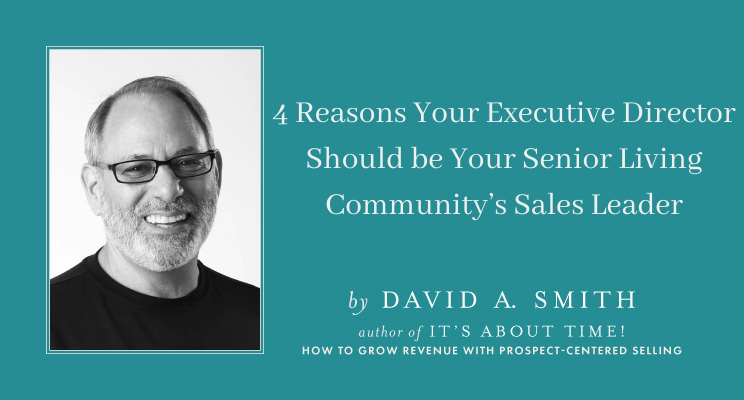Empower and Motivate Your Sales Counselors Using New Metrics for Success
The following is adapted from It’s About Time!
In the decades I’ve spent in senior living sales, I’ve seen over and over that one of the biggest barriers to success comes when you use traditional metrics to measure how effective your sales counselors are.
If you only celebrate closings, the sales team suffers from having only about five events per month to celebrate. It’s discouraging. Just counting sales and lost lead outcomes is also not an effective way to gauge, predict, or enhance day-to-day sales performance. It also won’t actually help the higher-functioning prospects to make a positive change in their lives.
That’s why, if you want to motivate your sales counselors, you need new metrics for success. You need a different and better way to track, classify, and prioritize the active lead base. The good news is that, with the right metrics, not only can you empower and intrinsically motivate your sales team, you can also facilitate a process that helps prospects and their key influencers address and overcome deep-seated emotional barriers to change.
Deciding what metrics to use comes down to two very important things: understanding what an advance is and how to generate more of them. Get these right, and not only will your sales conversion rates increase, but your sales counselors will have a much better understanding of how to help their prospects work through any resistance they feel until they’ve made a logical decision to buy.
What is an Advance?
Each advance is a small success. Each one takes time, preparation, and follow-up. In his book SPIN Selling, Neil Rackham says advances occur “when an event that takes place, either during a call or visit or just after it, that moves the sale forward toward a decision…by understanding what kind of advance would be required to make a call or visit successful, top salespeople set…objectives [engagement targets] that move sales forward.”
An advance in the senior living sales scenario occurs when something happens that demonstrates that the prospect is moving toward “ready to buy.” They advance when they are more ready, emotionally, to begin to evaluate possibilities and options rationally and logically. This “something” could be changes in health, living situation, support system, or some other life-impacting event.
Advances could also come from a sales counselor purposefully and regularly engaging with prospects during home visits and personalized creative follow-up (CFU). Whatever the “something” is, the prospect has a new awareness and/or stronger motivation to logically confront problems in their current living situation.
This kind of advance motivates higher-functioning prospects to confront their ambivalence and do something toward making a change – before a crisis forces them to. Because of that, it’s a meaningful result for sales counselors to target.
What Advances Should You Measure?
By thinking of each advance as a small but significant “close,” you start to get a good idea of how to measure your sales counselors’ success while empowering and motivating them to help their prospect advance towards the final goal of buying. In general, there are three areas where advances can happen:
- Time: When prospects or their decision influencers agree to meet with you or schedule a phone call, that commitment to engage time is an advance.
- Emotional engagement: A prospect connects with you and then answers personal, emotionally charged questions. They actively participate in direct conversations about their current and desired situations, or they lower their emotional barriers and share personal information.
- Commitment: When prospects share personal financial information, make introductions to important decision influencers, agree to take tours, allow a home visit, or follow up, it is an advance. It’s also an advance when they commit to seriously consider your community as a place to live, make a deposit, or sign a contract.
Small, incremental advances are possible multiple times every day and with most of your qualified prospects, even the “cold” leads. Measuring and tracking each of these various types of advances provides an ongoing, granular, and relevant view of sales effectiveness.
Examples of Strategic Advances
When your sales counselors focus on strategic advances, they can guide higher-functioning prospects toward getting ready to move. This opens up the possibility of converting substantially more prospects. By making empathic connections, untangling emotional resistance, and then making a strategic advance, you get to the point where the prospect is ready to make a logical decision about when and where to move.
On a foundational level, your readiness advancement strategy should be associated with what stage of the journey your prospect is on. For example, perhaps your prospect is in the Denial stage: they don’t want to accept that they need to move—they’re stuck and hoping for a miracle. In this instance, the next strategic advance occurs when the prospect thinks about problems and difficulties in their current residence.
To help the prospect make this advance, the sales counselor can build trust with the prospect and validate their feelings. They can explore expected outcomes of staying home without expressing judgment about the prospect’s desire to stay where they are. They can evoke life stories and listen for themes and values.
Any and all of these things can lead the prospect to their next strategic advance, because they’ll help the prospect begin to move through their emotional resistance to moving. Creating and using metrics to track the counselor’s success at helping the prospect make the next strategic advance will help keep them motivated to stick with the process and take the necessary actions to help their prospect eventually arrive at the logical conclusion that their life will be better once they move.
Measure Strategic Advances
Creating new metrics that measure successful strategic advances will motivate and inspire senior living sales professionals to engage in meaningful and proactive outreach, particularly for higher-functioning or “cold” leads. The best strategy to do this will evolve as untangled prospect emotions reveal themselves through life stories and trust breakthroughs.
Obviously, your counselors can employ a variety of tactics to guide their prospects to the next strategic advance: emails, Skype, Zoom, home visits, event invitations, meaningful CFU, or an on-site tour. By measuring the effectiveness of those tactics as they relate to strategic advances (and not just closings), you can keep your sales team moving forward while getting the information you need to adjust tactics as necessary.
Remember, a consistent focus on advances with higher-functioning prospects adds up. Over time, it is more advances, rather than more inquiries or more tours, that produces more sales. That’s why you should celebrate every advance as a success, even if it doesn’t directly result in an immediate sale.
For more advice on how to help senior-living prospects overcome their emotional resistance to change, you can find It’s About Time! on Amazon.


